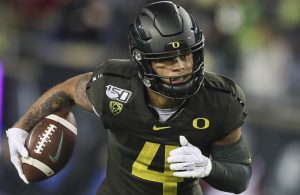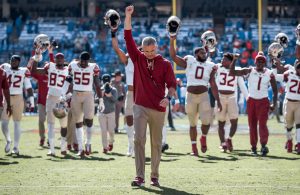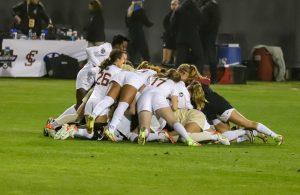- Sunday Seminole Summary: FSU Football Adds Pair of WR Transfers
- Sunday Seminole Summary: FSU Football Exits ESD With Top-15 Class
- Sunday Seminole Summary: FSU Soccer Tops BYU for Third National Championship
- Sunday Seminole Summary: FSU Soccer Advances to National Championship Match
- Seminole Sunday Summary: FSU Soccer Heads Back to College Cup
- Seminole Sunday Summary: FSU Soccer Reaches Sweet 16; Football Tops Boston College
- Seminole Sunday Summary: FSU Soccer Wins ACC, Advances to Second Round of NCAA Tournament; FSU Football Rallies Past Miami
- Seminole Sunday Summary: FSU Soccer Tops Wake on OT to Advance to ACC Final
- Seminole Sunday Summary: FSU Football Crushes UMass for Third Straight Win
- Seminole Sunday Summary: FSU Soccer Stays Perfect with Pair of Wins
Are Florida State’s Wide Receiver Draft Struggles Common?
- By Clint Eiland
- Updated: May 17, 2017
 Ross Obley/FSU athletics
Ross Obley/FSU athleticsOne of the more surprising draft-day occurrences was that of Travis Rudolph’s slide. The former Florida State wide receiver was originally projected as a mid-to-late round draft pick, with most projections putting him in the fourth to sixth range.
Instead, Rudolph fell out of the draft completely, becoming an undrafted free agent before signing with the New York Giants. Exactly 32 wide receivers were selected by various teams and somehow Rudolph was not one of them. It was a disappointing result for a player that had been so prominent for the Seminoles the past three years.
Rudolph’s career is not over yet, and he could still potentially turn heads in the NFL. But his fall in the draft continues a supposedly less-than-stellar record of Florida State receivers being passed over on draft day.
Since 2007 (the year current wide receiver coach Lawrence Dawsey was hired), the Seminoles have seen only three wide receivers get drafted. Some fans believe that it is a coaching issue, while others think that the numbers lack context. This topic has been alluded to before, but the discussion about wide receivers (rightfully) tends to focus on how they actually perform while at FSU.
That is not the discussion we intend to shed light on here. Instead, we are hoping to answer a different question: Does Florida State have a problem when it comes wide receivers in the draft?
To help us with our answer, we looked at 10 schools and their wide receiver picks in the NFL Draft from 2014-17. We then looked at their recruiting classes from 2011 to 2014, and attempted to see if there was any correlation between the talent they brought in and the results they had in the draft. One “pending” class would be the wide receivers from 2014 that returned for a senior year.
There are some notes to be aware of. Teams were chosen because they recruit on the same general level as Florida State. Whenever it is apparent that a recruit did not qualify, they will not count towards a team’s number of players. However, there may still be some that slipped through the cracks or were listed as signing with the school.
Some of the drafted wide receivers were not actually listed as wide receivers in their recruiting profiles. A few were just classified as athletes, so they will not be counted in the raw number of receivers either recruited or drafted.
Keep in mind that there could still be a disconnect between the players that got drafted and the top 50 players that were recruited. As in, being part of the latter does not necessarily make you part of the former. The intent with the top 50 receivers section is to display the talent that teams are bringing in. It could potentially indicate which programs are being helped by this influx or which are not producing like they should.
All numbers are from the 247Sports Composite and their position rankings for the recruiting years listed.
| # of Rec. Drafted | # of Rec. Recruited | # of Top 50 Rec. Recruited | |
| Ohio State | 6 | 12 | 6 |
| LSU | 4 | 13 | 8 |
| Michigan | 4 | 8 | 1 |
| Alabama | 3 | 11 | 9 |
| USC | 3 | 6 | 4 |
| UCLA | 3 | 10 | 4 |
| Notre Dame | 2 | 9 | 6 |
| Florida State | 2 | 8 | 7 |
| Auburn | 2 | 9 | 6 |
| Texas A&M | 2 | 14 | 6 |
Looking at the table, it becomes apparent that there will not be much of a spread when it comes to the raw numbers. With a minimum of two and maximum of six, the difference in drafted wide receivers shows no serious advantage towards one team.
The draft itself is an unpredictable event — having three receivers chosen versus two is the luck of the draw. This applies more so to late round picks. That being said, a group of schools stand out when looking deeper into the numbers.
Ohio State, Michigan, and USC have the best ratio when it comes to receivers drafted to receivers recruited. Each has 1:2 mark, with Ohio State coming out on top with the six total receivers taken. USC was hit by sanctions at this time and had its scholarship numbers reduced.
Michigan seems to be the surprise of the group. The Wolverines are near the bottom of both receivers recruited and top 50 receivers recruited. Yet they still maintained four draft picks and a good ratio. That’s a sign of either good development, good scouting, or a bit of both.
Florida State is in the “bottom tier” of receivers drafted. Only two players (Kelvin Benjamin and Rashad Greene) have been selected in the time frame, putting the Seminoles with Notre Dame, Auburn, and Texas A&M.
The result seems to be slightly mixed when put into context. Florida State generally did not recruit that many receivers — eight total is tied with Michigan for the second least in the whole group. That is the best ratio of the four teams it is grouped with.
On the other hand, the number of top 50 receivers recruited provides insight to why some Florida State fans feel disappointed. The Seminoles have seven of them, which is the third most on the whole table. Yet they have the least receivers drafted of the top 3. Florida State is bringing in good talent at the wide receiver position, but it is not getting the draft results that similarly talented teams are.
Obviously it is never cut and dry. Is it Florida State’s fault that Marvin Bracy left to pursue Olympic sprinting? Is it Florida State’s fault that Isaiah Jones left the program after injuries and academic qualification issues? Of course not. But one could find similar examples on all of the teams listed.
The biggest takeaway from the chart should be this: Florida State is not all that different from other elite programs. Even the likes of Alabama and LSU are not overwhelmingly better at producing NFL wide receivers. Often times fans become too focused on their own team and assume that no one else has the same issue. Texas A&M fans might want to take a look at the table and wonder what has happened with their receiving corps.
It should also be included that perhaps the Seminoles should be doing better at converting talent into results. Whether or not that changes in the coming years will need to be seen. Auden Tate is on a good path to get drafted, while players like Keith Gavin and George Campbell have the physical attributes that the NFL values these days.
Right now, Florida State has possibly the most talented group of receivers it has assembled in a long time. There are five currently on the roster that were considered blue chip recruits, and the depth chart has plenty of space left up top for contributors. Players like Da’Vante Phillips, George Campbell, and Keith Gavin are all expected to join Auden Tate and Nyqwan Murray for reps.
If in three years the numbers remain similar, it will have shown on the field. But only time will tell.




You must be logged in to post a comment Login